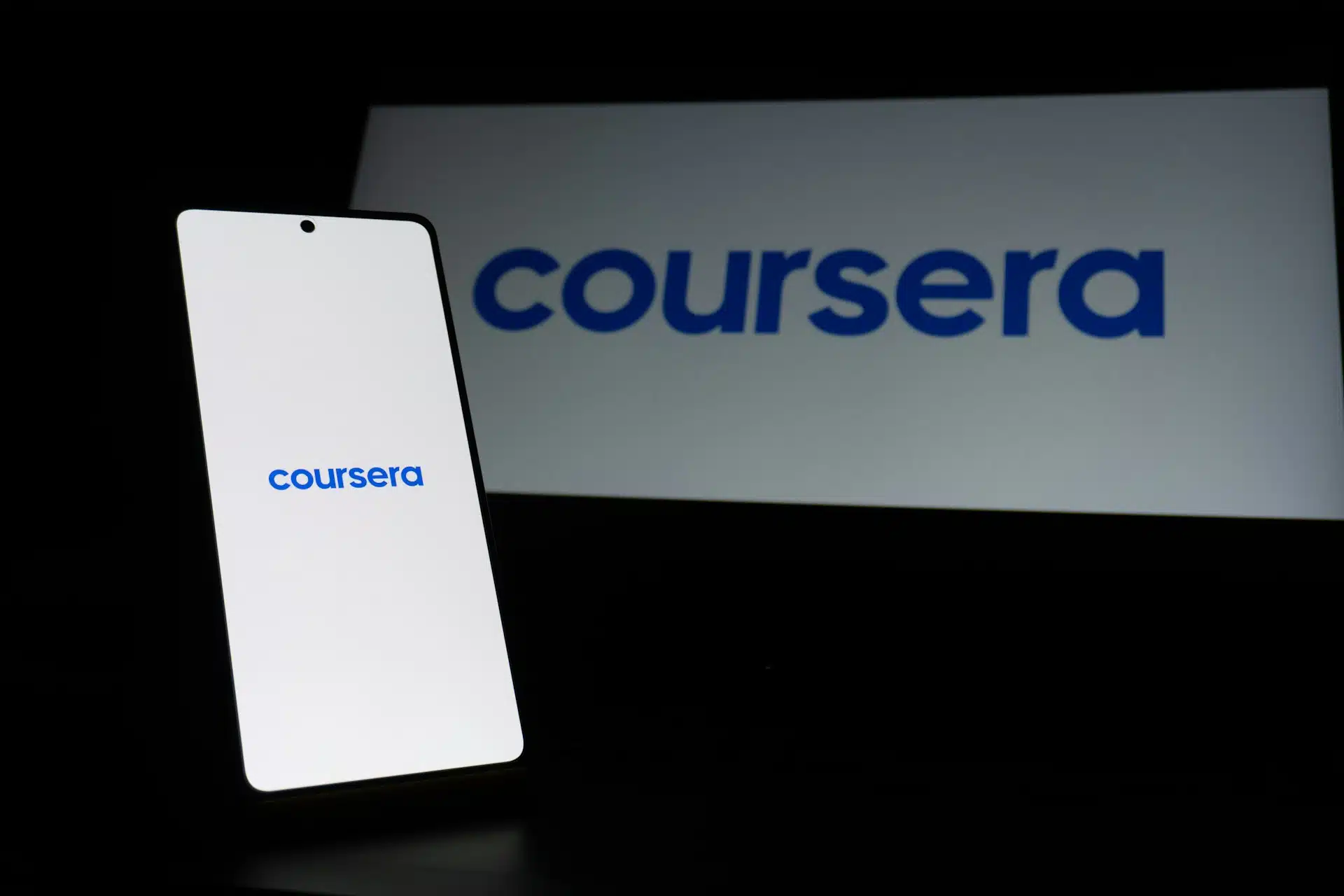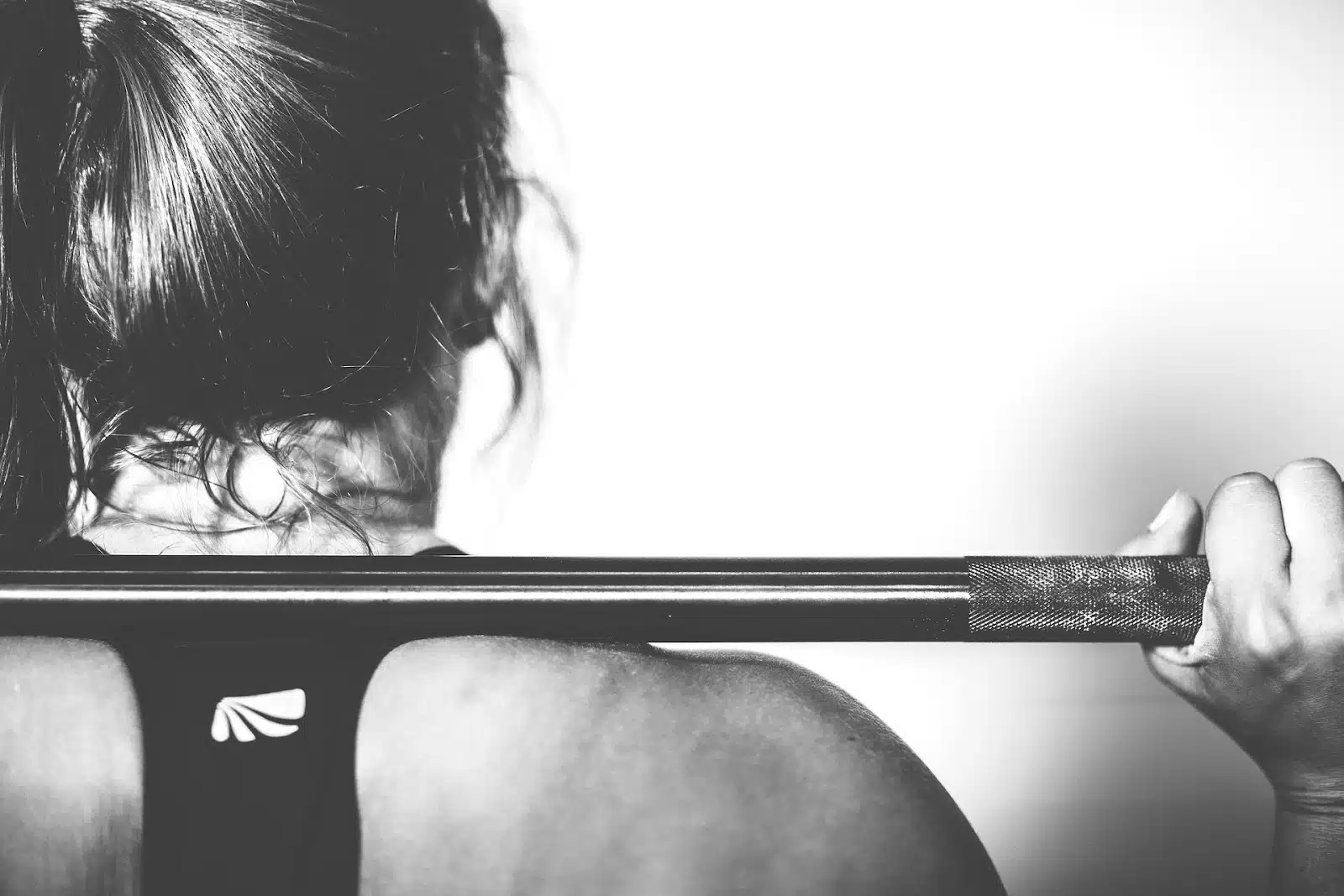
The deadlift is often the first choice when gym goers like myself think of strength training, but it is not always practical or safe for everyone.
Issues like lower back discomfort, limited equipment access, or recovery concerns can make the traditional barbell deadlift less than great at all times. Yet, the benefits it offers, a strong posterior chain, improved athletic performance, and full-body coordination, are too good to ignore.
Fortunately, these results are not exclusive to deadlift only. Various movements can target the same muscle groups, promote functional strength, and even improve range of motion.
After extensive network research and personal trial, I’ve found six highly effective alternatives to the deadlift. These exercises target the same major muscle groups, challenge stability, and can be incorporated into both home and gym settings. In this guide, I’ll share each alternative, explain how to perform it correctly, reveal common performance mistakes/solutions, and provide you with tips on incorporating them into your workouts.
But are you curious about how I picked them out? Yeah? Check it out below, then.
How I tested and chose these deadlift alternatives
When choosing these six exercises, I didn’t just pick popular movements; I applied specific criteria to ensure they serve as adequate deadlift substitutes. Here’s what guided my selection:
- Muscle activation: Each alternative engages the posterior chain to a similar degree as a deadlift.
- Progressive overload capability: You can increase weight or resistance over time for ongoing strength gains.
- Accessibility: Options include exercises for both home and gym environments.
- Safety and adaptability: They’re suitable for lifters of varying experience levels and those with prior injuries.
Without any further words, let’s head into the main course of this article.
The 6 best deadlift alternatives
1. Trap Bar Deadlift
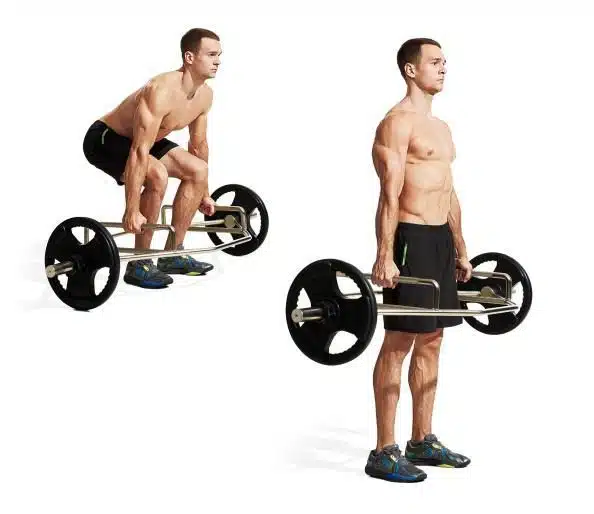
Why it’s a great alternative:
The trap bar deadlift (also called the hex bar deadlift) is one of the most popular substitutes for the conventional deadlift. Its neutral grip and centered load position reduce stress on the lower back, allowing you to lift heavy weights, making it great for both beginners and athletes.
How to do it:
- Stand inside the trap bar with your feet hip-width apart and your toes slightly pointed out.
- Bend at the hips and knees while keeping your chest up and spine neutral.
- Grip the handles of the trap bar firmly with both hands.
- Engage your core and drive through your heels as you stand up, keeping the bar close to your body.
- Fully extend your hips and knees at the top without hyperextending your back.
- Lower the bar slowly back to the floor by hinging at your hips first, then bending your knees.
Muscles worked:
- Quadriceps
- Glutes
- Hamstrings
- Erector Spinae
- Trapezius
- Forearms
Common mistakes you might make and their fixes:
Mistake: Letting your knees cave inward.
Fix: Push your knees outward slightly during the lift to maintain alignment.
Mistake: Rounding the lower back.
Fix: Keep your chest up and shoulders back to maintain a neutral spine.
Mistake: Rising hips too early.
Fix: Drive through your heels and keep your hips and shoulders rising simultaneously.
Pro-tip:
If you have limited mobility, use high handles, as they shorten the range of motion and make movement safer.
2. Romanian Deadlift (RDL)
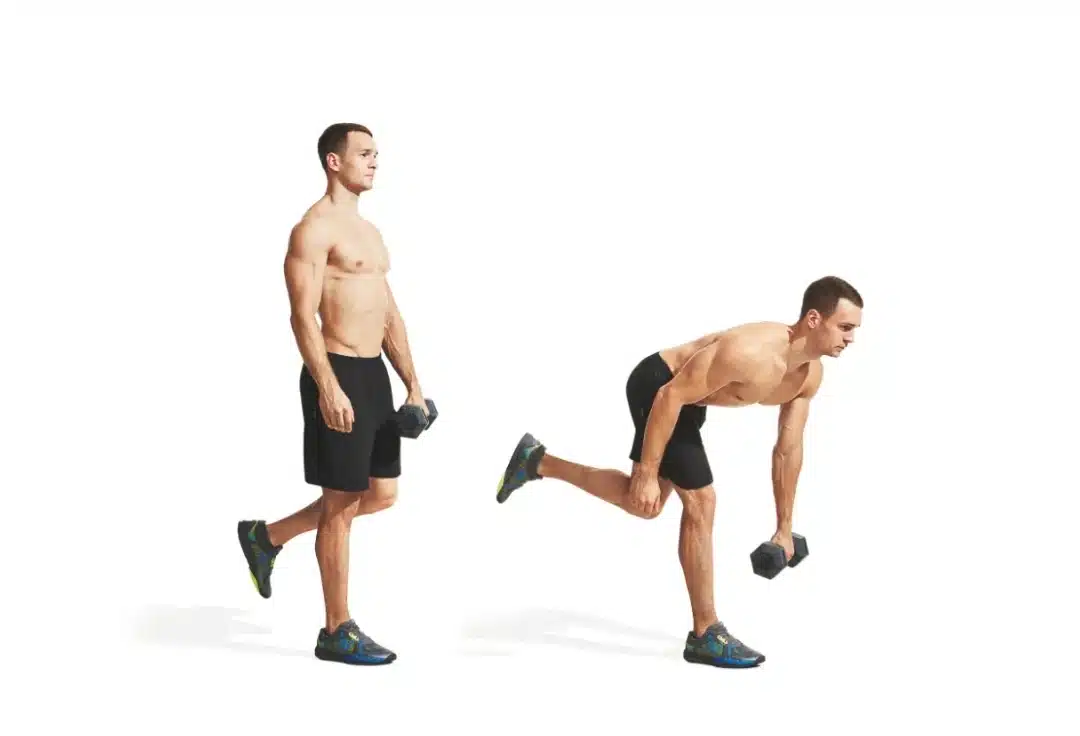
Why it’s a great alternative:
The Romanian Deadlift is a staple for developing hamstring and glute strength. Unlike the conventional deadlift, the RDL focuses on the eccentric (lowering) phase and hip hinge pattern, which improves posterior chain stability and flexibility.
How to do it:
- Stand with your feet hip-width apart, holding a barbell or dumbbells in front of your thighs with an overhand grip.
- Keep your knees slightly bent and your back straight throughout the movement.
- Hinge at your hips, pushing them backward while lowering the weight along your legs.
- Lower until you feel a stretch in your hamstrings (usually just below the knees).
- Engage your glutes and hamstrings to return to the starting position without rounding your spine.
Muscles worked:
- Hamstrings
- Glutes
- Erector Spinae
- Adductors
- Core
Common mistakes you might make and their fixes:
Mistake: Bending your knees too much, turning it into a squat.
Fix: Keep your knees slightly bent but fixed throughout the movement.
Mistake: Hyperextending your back at the top.
Fix: Finish in a neutral position with your ribs down and abs tight.
Mistake: Rounding your shoulders forward.
Fix: Pull your shoulder blades back and down before hinging.
Pro-tip:
Slow down the lowering phase to maximize hamstring activation and improve flexibility.
3. Glute Bridge
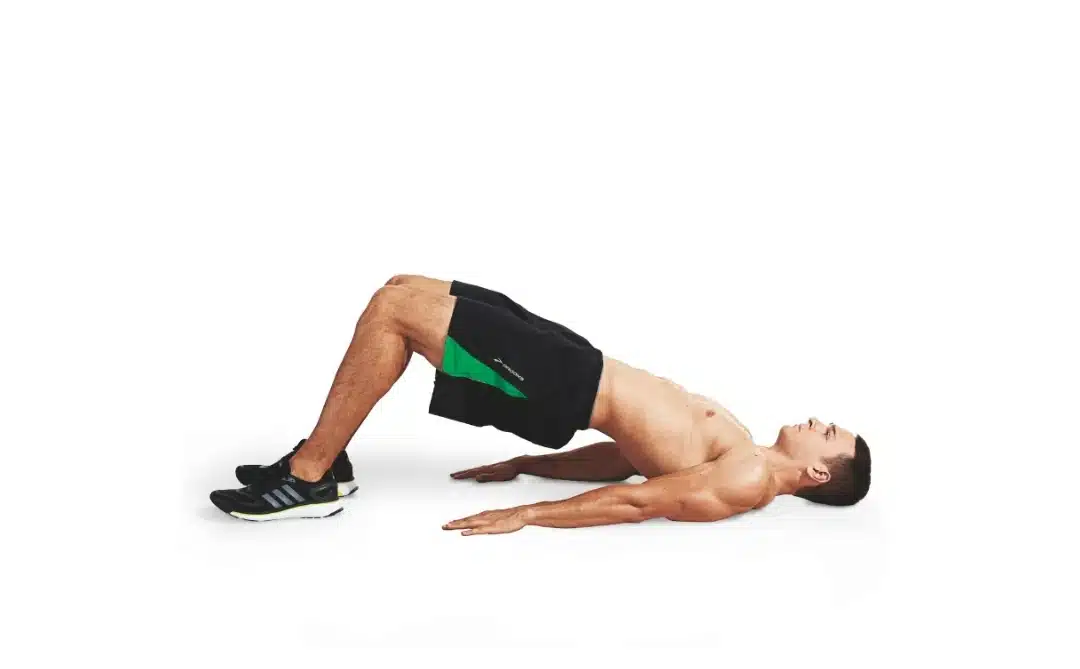
Why it’s a great alternative:
Glute bridges are an excellent alternative for targeting glutes and hamstrings without putting heavy loads on the spine. It’s a bodyweight exercise that can easily progress with resistance bands or weights.
How to do it:
- Lie on your back with your knees bent and feet flat on the ground, hip-width apart.
- Place your arms at your sides, palms facing down.
- Press through your heels and lift your hips toward the ceiling until your knees, hips, and shoulders form a straight line.
- Squeeze your glutes hard at the top and hold for a second.
- Slowly lower your hips back to the floor without relaxing completely.
Muscles worked:
- Glutes (primary)
- Hamstrings
- Core
Common mistakes you might make and their fixes:
Mistake: Arching your lower back excessively.
Fix: Tuck your pelvis slightly and engage your core before lifting.
Mistake: Pushing through your toes instead of your heels.
Fix: Drive through your heels to activate the glutes properly.
Mistake: Flaring your knees outward too far.
Fix: Keep knees aligned with hips and toes.
Pro-tip:
Add a barbell or resistance band across your hips for increased intensity and progressive overload.
4. Russian Kettlebell Swing
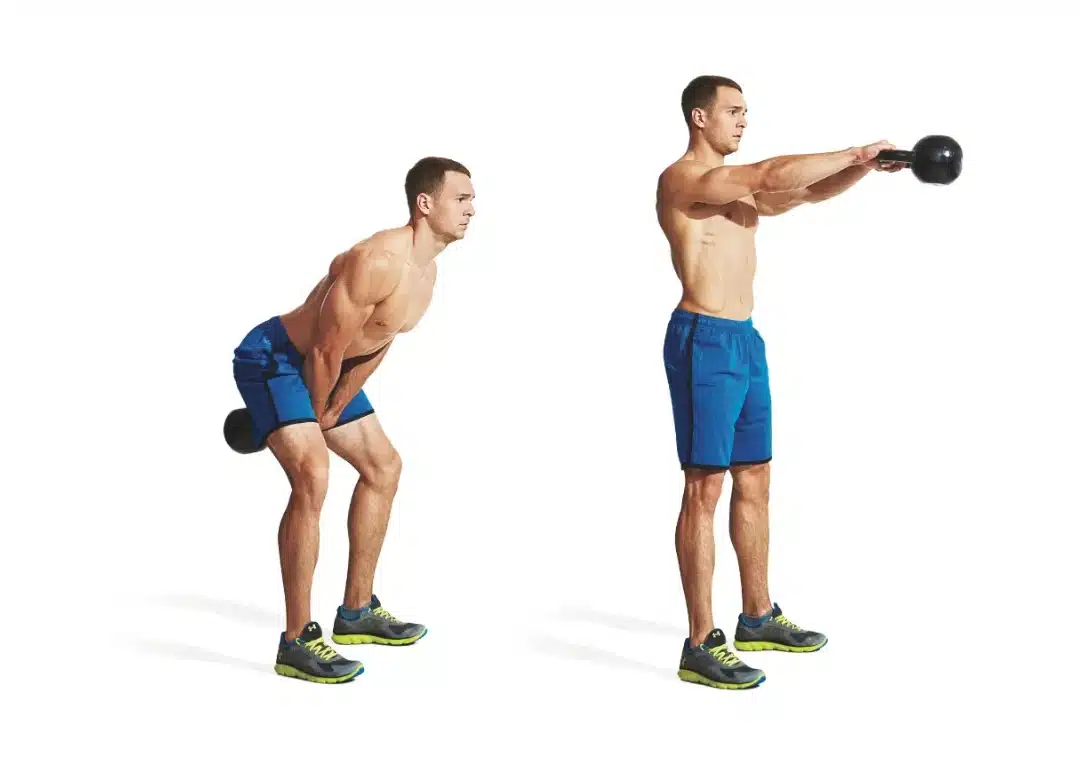
Why it’s a great alternative:
The kettlebell swing develops hip explosiveness, posterior chain strength, and conditioning. It’s a dynamic alternative that improves power transfer for athletes while reducing spinal loading compared to heavy deadlifts.
How to do it:
- Stand with your feet slightly wider than hip-width apart, holding a kettlebell with both hands.
- Hinge at your hips and slightly bend your knees as you bring the kettlebell back between your legs.
- Drive your hips forward explosively to swing the kettlebell to chest height (Russian swing) while keeping your arms straight.
- Let the kettlebell swing back down naturally as you hinge again for the next rep.
Muscles worked:
- Glutes
- Hamstrings
- Lower Back
- Core
- Shoulders (stabilization)
Common mistakes you might make and their fixes:
Mistake: Squatting instead of hinging.
Fix: Push your hips back like a deadlift, not down like a squat.
Mistake: Using arms to lift the kettlebell.
Fix: Power should come from the hips; arms act as guides only.
Mistake: Rounding your back during the swing.
Fix: Keep your chest up and engage your lats to protect your spine.
Pro-tip:
Start with lightweight to perfect form before moving to heavier kettlebells for explosive power.
5. Barbell Hip Thrust
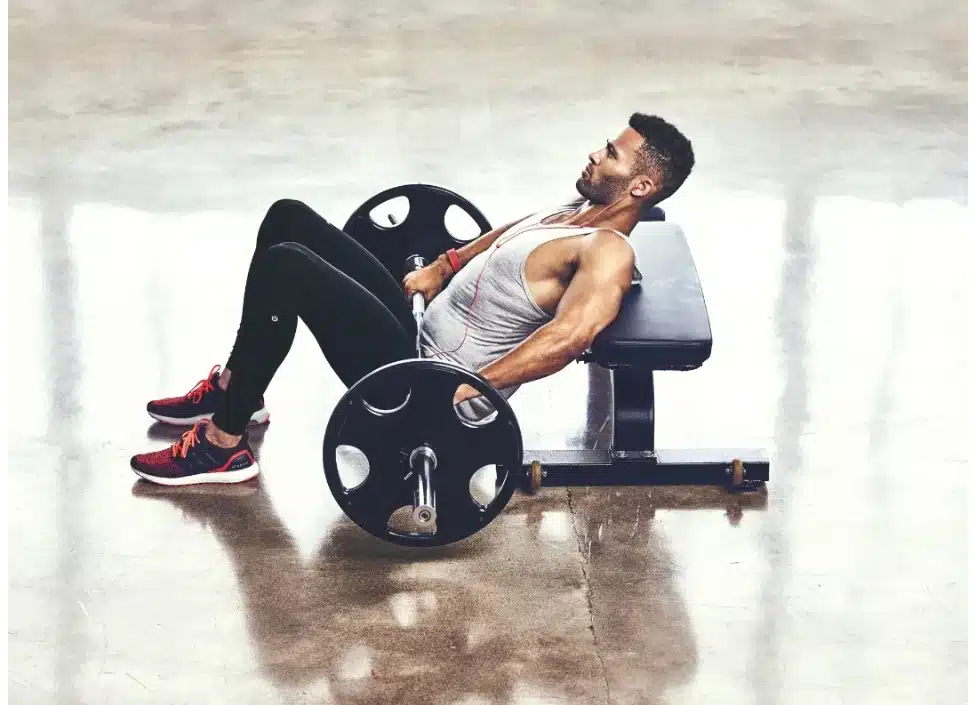
Why it’s a great alternative
The hip thrust is one of the best exercises for building glute strength and size. It places the glutes under tension through an extensive range of motion without heavily loading the spine.
How to do it:
- Sit on the floor with your upper back against a bench and a loaded barbell over your hips.
- Roll the barbell so it rests comfortably across your hips (use a pad for cushioning).
- Plant your feet flat on the ground, shoulder-width apart, and bend your knees to about 90 degrees.
- Drive through your heels and extend your hips upward until your torso is parallel to the ground.
- Squeeze your glutes at the top, then slowly lower back down without letting your hips rest entirely on the floor.
Muscles worked:
- Glutes (primary)
- Hamstrings
- Quadriceps (secondary)
- Core
Common mistakes you might make and their fixes:
Mistake: Overextending the lower back at the top.
Fix: Keep ribs down and avoid arching; lock out with glutes, not the spine.
Mistake: Placing feet too far forward or backward.
Fix: Adjust your foot position so your shins are vertical at the movement’s top.
Mistake: Letting knees collapse inward.
Fix: Actively push knees outward throughout the lift.
Pro-tip:
Pause for 1–2 seconds at the top for maximum glute activation.
6. Good Morning (with Resistance Bands)
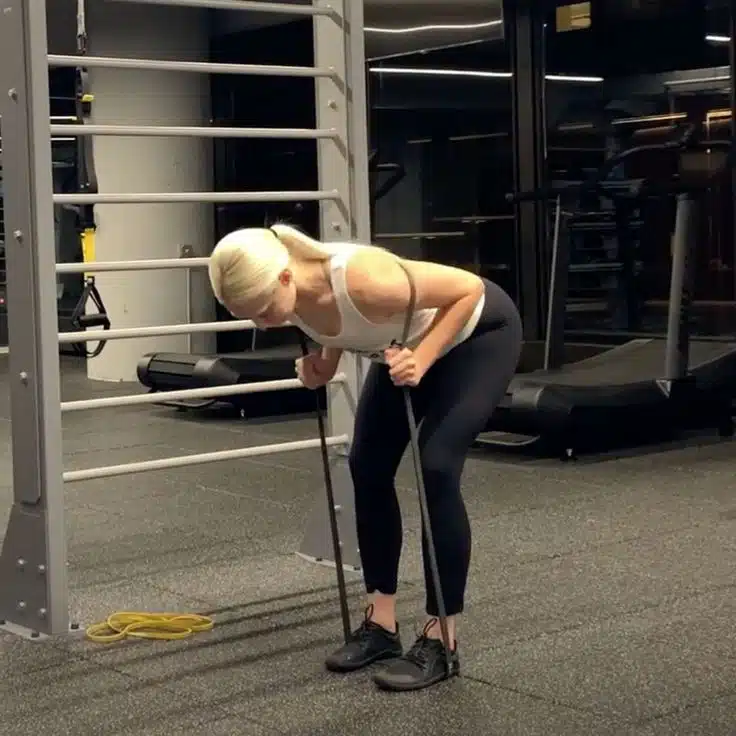
Why it’s a great alternative
Good mornings are an excellent hip hinge movement that strengthens the hamstrings, glutes, and spinal erectors. Using resistance bands makes them joint-friendly and portable, perfect for home workouts.
How to do it:
- Stand in the center of a resistance band and loop the other end around the back of your neck or across your upper traps.
- Keep your feet shoulder-width apart and a slight bend in your knees.
- Brace your core and hinge at your hips, lowering your torso forward while maintaining a straight back.
- Go down until your torso is almost parallel to the ground, then drive your hips forward to return to the starting position.
Muscles worked:
- Hamstrings
- Glutes
- Lower Back
- Core
Common mistakes you might make and their fixes:
Mistake: Rounding your spine during the hinge.
Fix: Keep your chest up and shoulders back at all times.
Mistake: Locking knees completely.
Fix: Maintain a soft bend to reduce stress on the joints.
Mistake: Letting the band slip or pull unevenly.
Fix: Position the band securely before starting the movement.
Pro-tip:
Control the tempo (slow on the way down and powerful on the way up) for maximum tension and safety.
How to Incorporate These Alternatives into Your Routine
Integrating these six deadlift alternatives into your workout plan depends on your fitness level, goals, and recovery needs. The goal is to mimic the benefits of the conventional deadlift (strength, stability, and posterior chain development) while reducing injury risk or accommodating equipment limitations. So do this:
Step 1: Assess your goals
- Strength focus: Prioritize heavier compound lifts, such as the Trap Bar Deadlift, Romanian Deadlift, and Barbell Hip Thrust, for progressive overload.
- Glute and hamstring development: Emphasize Glute Bridges, Barbell Hip Thrusts, and Good-Mornings with controlled tempo.
- Power and explosiveness: Include Russian Kettlebell Swings for hip hinge speed and dynamic hip extension.
Step 2: Choose 2–3 key movements per session
You don’t need all six in a single workout. A balanced lower-body session might look like:
- Main lift: Trap Bar Deadlift or Barbell Hip Thrust
- Accessory lift: Romanian Deadlift or Good-Morning
- Power/Conditioning: Russian Kettlebell Swing or Glute Bridge
Example split for two lower-body days:
- Day 1: Trap Bar Deadlift + Glute Bridge + Russian Kettlebell Swing
- Day 2: Barbell Hip Thrust + Romanian Deadlift + Good-Morning
Step 3: Determine reps and sets
- Heavy lifts (Trap Bar Deadlift, Hip Thrust): 3–5 sets of 4–8 reps at 70–85% of 1RM
- Accessory movements (RDL, Good-Morning): 3–4 sets of 8–12 reps for muscle hypertrophy
- Explosive swings: 3–4 sets of 15–20 swings for power
Step 4: Prioritize recovery
- These lifts heavily tax the posterior chain. Incorporate:
- 48 hours rest between sessions targeting similar muscle groups
- Active recovery, like walking or mobility drills on off-days
Step 5: Progress gradually
- Start with moderate loads and perfect your form. Progress by:
- Adding 5–10 lbs per week for heavy lifts
- Increasing range of motion for mobility-friendly moves
- Incorporating resistance bands for extra tension
- And just like that, you’d hack it.
So,
The deadlift is a classic strength builder, but it is not the only way to train the posterior chain. The six exercises in this guide (Trap Bar Deadlift, Romanian Deadlift, Barbell Hip Thrust, Glute Bridge, Good Morning with Resistance Band, and Russian Kettlebell Swing) offer safe and effective alternatives for various needs.
Each movement has its own advantage. Trap Bar Deadlifts allow heavy loading with less spinal stress. Romanian Deadlifts emphasize hamstrings through controlled hip hinging. Barbell Hip Thrusts and Glute Bridges directly target glutes, improving strength and stability. Good Mornings with a Resistance Band build posterior chain endurance while reducing joint strain. Russian Kettlebell Swings develop explosive hip power and cardiovascular conditioning with minimal equipment.
Incorporating these lifts into your training provides versatility, reduces injury risk, and supports long-term progress. Rotate them strategically, follow proper form, and adjust the load to match your capacity. Deadlift alternatives are not a compromise, but innovative ways to train effectively and sustainably when traditional deadlifts aren’t an option.
FAQs About Deadlift Alternatives
1. Are deadlift alternatives as effective as traditional deadlifts?
- Yes, if performed intentionally. While no single exercise can completely replicate the full-body engagement of a deadlift, combining alternatives like the trap bar deadlift for overall pulling strength and the Romanian deadlift for hamstring development can match or even exceed the benefits for specific muscle groups.
2. Can beginners use deadlift alternatives instead of conventional deadlifts?
- Absolutely. Many alternatives are safer and easier to learn than traditional deadlifts, requiring precise form. For example, glute bridges or barbell hip thrusts enable beginners to strengthen the posterior chain without overstressing the lower back.
3. Which deadlift alternative targets the same muscles as a conventional deadlift?
- The trap bar deadlift is the closest match. It engages the glutes, hamstrings, quads, and lower back while reducing spinal shear stress compared to a straight-bar deadlift. If you want the most similar movement pattern, start there.
4. Are these alternatives better for people with lower back pain?
- Yes, in most cases. Exercises like hip thrusts, glute bridges, and good mornings with resistance bands reduce spinal compression and shear forces compared to conventional deadlifts. However, always consult a physical therapist if you have an existing injury.
5. How often should I train deadlift alternatives?
- Two to three times per week works well for most people, provided you manage the overall training volume. Rotate exercises (e.g., trap bar one day, RDL another) to hit different angles and reduce overuse injuries.
6. Which alternative is best for glute growth?
- The barbell hip thrust and glute bridge are top choices for isolating and activating the glutes. Studies show they produce some of the highest EMG activity for the glutes compared to other hip-dominant exercises.
7. Can I combine multiple deadlift alternatives in the same workout?
Yes, and it’s often the best approach. For example:
- Trap Bar Deadlift → primary strength lift
- Romanian Deadlift → hamstring-focused accessory
- Barbell Hip Thrust → glute isolation finisher
This combination ensures balanced development of the posterior chain.
8. How should I replace deadlifts completely?
If you have:
- Chronic lower back pain
- Limited mobility preventing safe form
- Lack of necessary equipment
Then, using alternatives makes sense. Otherwise, combining deadlifts with these variations often produces the best overall strength and muscle-building results.










